
|
|
|
>> Log Breakdown, Related Machinery and Facilities |
|
Planers
|
Planers, also called surfacers, are woodworking machines used to
dress and size rough-sawed lumber on one or more sides, planing
boards to an even thickness.
Operator Involvement
The operator adjusts the planer for the cut and then feeds stock
into the in-feed side of the machine. The surface board is
retrieved from the out-running end.
|
|
|
|
|
|
|
Hazard/Solutions:
Contact may occur with the cutter head, belts and
pulleys, or other machinery.
- All cutting heads must be guarded.
1910.265(e)(6)(i)(a)
Provide barriers at the loading and unloading ends
to keep hands out of point of operation.
|
|
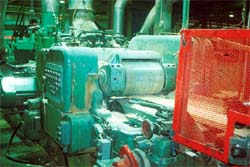
Infeed to planer feed
roll is inadequately guarded.
|
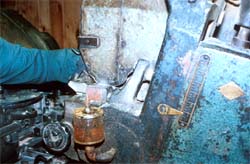
A worker manually adjusts tolerances of
cutting heads with the machine running.
|
|
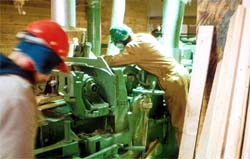
Manually adjusting cutting tolerances of
planer
|
- Pressure feed rolls and "pineapples" must be guarded.
1910.265(e)(6)(i)(c)
- Completely enclose belts and pulleys of line shaft with sheet metal or heavy mesh guards; guards must
be used regardless of the location of the line
shaft.
[29 CFR 1910.219(a)(1)].
|
|
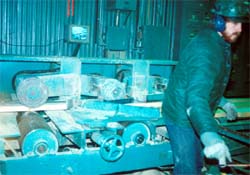
Infeed to planer. Note the unguarded
pineapple roll and infeed
roll.
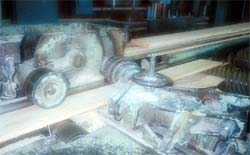
Board is fed into planer by pineapple
and cylindrical
infeed rolls.
|
- Cover cutting heads with a metal guard or cage.
The exhaust system may be integrated with the guard.
[29 CFR 1910.213(n)(1)].
|
|
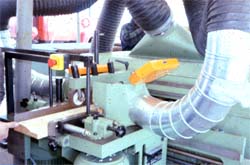
Exhaust hoods to remove planer
shavings from point of operation
|
|
|
|
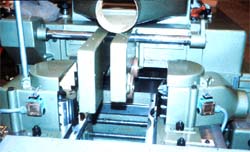
Interlocked guards on cutting
heads on planer
|
|

|
|
|
|
Hazard/Solution:
Clothing, hair, or hands may be
caught by and pulled into, the automatic feed mechanism.
- Guard feed rolls with a wide metal strip or bar
that will allow boards to pass but that will keep the operators' fingers out
[29
CFR 1910.213(n)(3)].
|
|
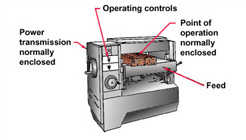
Planer with labeled parts
|
|

|
|
|
|
Hazard/Solution:
Stock may be thrown back at the operator
after being caught by the cutter head.
- Install anti-kickback fingers on the in-feed side
across the width of the machine. Stand back once the boards have been put
through to avoid injuries from kickback and
flying splinters. Do not feed boards of different thickness.
Thinner boards will be kicked back.
|

|
|
|
|
Hazard/Solution:
Work pieces, wood chips, and/or splinters
may be thrown by the cutting action.
- Use a barrier or guardrail when the machine is running.
|

|
|
|
|
Hazard/Solution:
Vibration and
noise produced from the machinery
may be harmful to the workers.
- Use an appropriate noise enclosure
for the planer. Ensure that the machinery
is anchored to, and insulated from, a solid
foundation. Use Personal Protective Equipment.
|
|
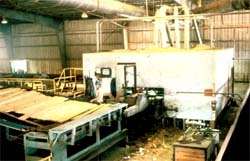
Noise enclosure for planer
|
|

|
|
|
| Home
| Log Handling
| Log Breakdown
| Dry
Kilns
| Lumber Storage
|
| Plant-Wide Hazards
| Definitions
| Additional
References
| User
Guide
| Credits
|
|
|
|
